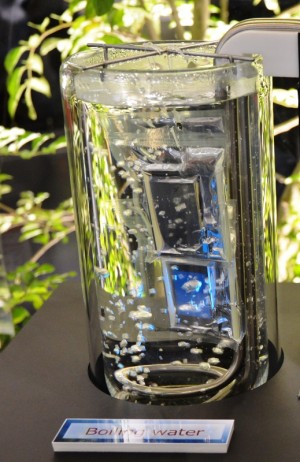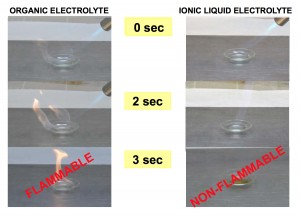Heat-resistant Li-ion battery tech works in boiling water
Battery fires are a big deal. They don’t just maim people, destroy expensive equipment and information, they also cost a lot of money and hold technology back. Sony had to recall about 10 million laptop batteries in 2006 due to fire risks, and the giant reportedly strained under the weight of that burden. Tesla Motors faced a major crisis at just the prospect of a recall over fires in its Tesla Model S, and even without it the company had to work to regain public trust. So, the next-generation of battery technology had better bring advances in safety as well as energy density — or, perhaps we can invent a safer version of the batteries we already have.
There’s no doubt that lithium ion is on the way out in the long term — but over such a long-term tail, the technology could still cause a lot of damage. That’s why Semiconductor Energy Laboratory (SEL) has worked out how to get lithium ion batteries working even at very high temperatures — attendees of Display Innovation 2014 got to see the battery working in a vat of boiling water! Better yet, their technology can take temperatures up to 300 degrees Celsius before igniting — more than 100 degrees higher than the competition. And as the boiling battery shows, it can maintain useful function at higher temperatures as well, even when outright fires aren’t an issue.

The innovation is the use of an as-yet-unnamed ionic liquid as a solvent of the electrolyte. An ionic liquid is just a liquid salt — literally, if you heat solid NaCl enough to melt it, you end up with an ionic solid. Remember though, that there are thousands of varieties of salts in nature, and many more we can create through science; we’ll need to know which salt it is to understand exactly what’s going on here. By whatever means, this ionic liquid acts as a heat stabilizer and keeps the system functioning. Whether it can do so affordably remains to be seen.

The problem with using ionic liquids has historically been that, well, they are basically the opposite of what you want in your electrolyte. The whole point of an electrolyte is to allow the energy carrier (lithium) to move quickly and easily, and liquid salts are made of charged particles that push other charges around. Introducing ionic liquids into the mix might help with your heat capacity, but it could make actually using the battery much less efficient — but, apparently, SEL has found one that works. This charge problem will become all the more difficult should we make the leap from lithium to magnesium ion batteries, as each magnesium ion could transport two electrons to lithium’s one; this extra charge is an impediment even with normal electrolyte solutions, let alone in a liquid salt.
Other, more divergent battery technologies could offer even bigger steps forward, though; dual carbon batteries create no heat at all, using cotton-derived carbon as both the electrodes and a more conventional organic electrolyte containing lithium. This means dual carbon batteries could still be flammable due to outside heat sources, but in absence of a nearby fire they ought to be incapable of causing a fire themselves.
The many upgrades to Li-ion technology currently making their way through the research pipe have a lot of potential, especially taken together, but they could all be undercut by a more fundamentally new technology, one that changes the game and leaves Li-ion behind entirely.
